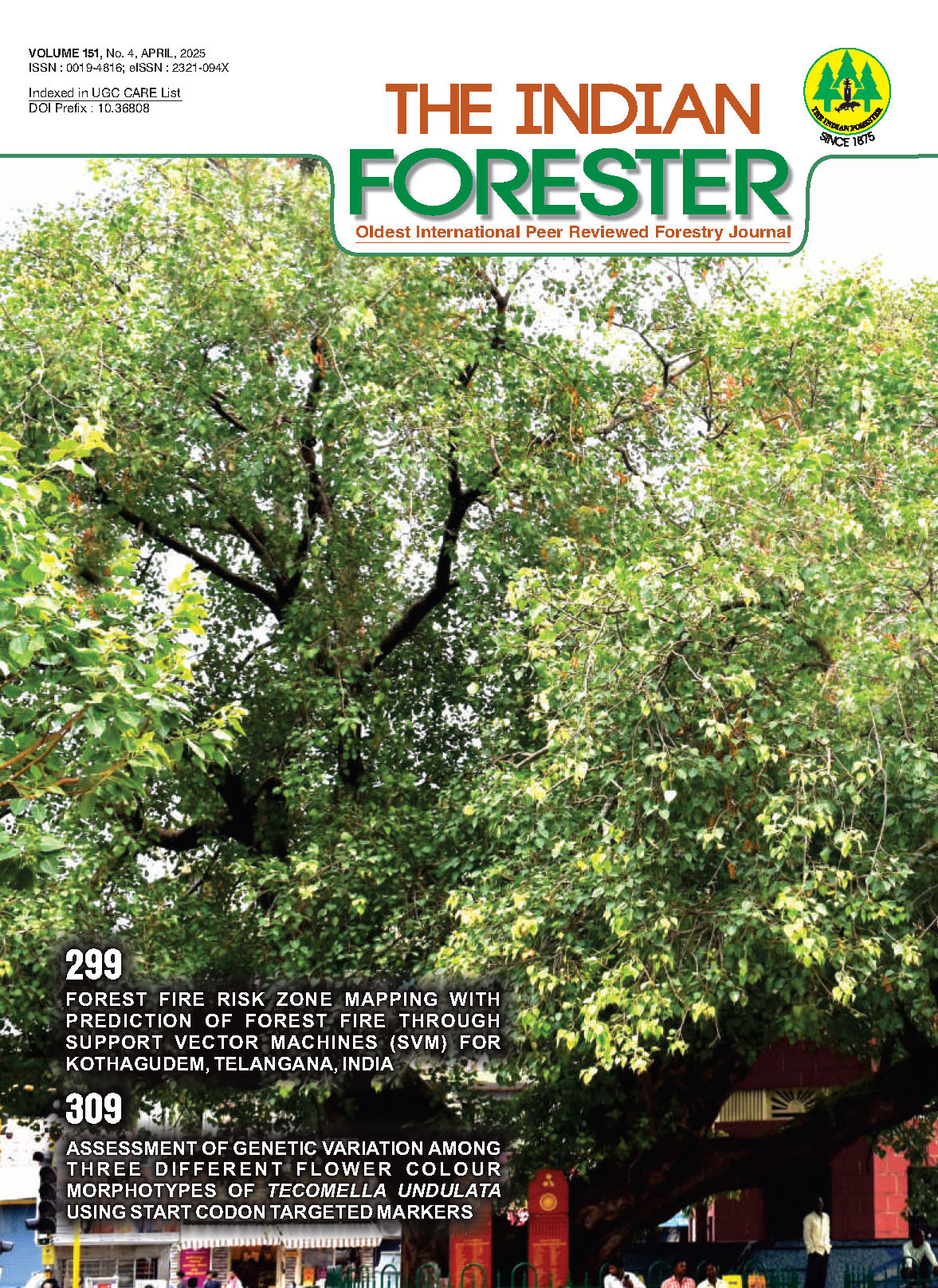Fuelwood Burning : Utilization Trends for Forest Sustainability in the Cold Desert of Trans Indian Himalaya
DOI:
https://doi.org/10.36808/if/2025/v151i4/169667Keywords:
Trans-Himalayas, Fuel wood, Energy, Resource use index, Lahaul valley.Abstract
In the Indian Himalayan region, heat energy consumption in terms of fuelwood is always given importance. This study has highlighted qualitative and quantitative consumption trends of fuelwood species utilized by people in the Lahaul Valley, a cold desert in the Trans-Indian Himalaya. For each plant species, the average quantum collection, probability of utilization, and Resource Use Index were assessed. The study revealed a diversity of 42 fuelwood species used by the tribal population. Among all the species, maximum Resource Use Index value and preference were recorded for Salix fragilis, followed by Juniperus polycarpos, and Pinus wallichiana. The study also highlighted the available stock of fuelwood species. In recent years, consumption pressure on fuelwood from the forests showed a declining trend, it could be the adoption of sustainable harvesting practices which will save energy by burning fuelwood. Of the total species, the higher dependence on native species (57.14%); near-endemic species (30.95%); and endemic species (2.38%) were recorded, this indicated the importance of these species for conservation. Hence, regular monitoring for extraction trends with changing attitudes of the people is required.
References
Aswal B.S. and Mehrotra B.N. (1994). Flora of Lahaul-Spiti (a cold desert in north-west Himalaya). Dehradun, Bishen Singh and Mahendra Pal Singh.
Bhat B.P. and Tomar J.M.S. (2002). Firewood properties of some Indian mountain trees and shrub species. Biomass and _ Bioenergy, 23(4): 257 260. https://doi.org/10.1016/S09619534(02)00057-0 DOI: https://doi.org/10.1016/S0961-9534(02)00057-0
Dar Maraju Din and Ahmad Suheel (2016). Current status and prospects of fuel wood species in North-Western Himalayan Region–a Review. Annals of Agri-Bio Research, 21(2): 164_167. ISSN: 0971-9660: 20173021689
Dhar U. and Samant S.S. (1993). Endemic diversity of Indian Himalaya. I. Ranunculaceae and II. Paeoniaceae. Journal of Biogeography, 20: 659–668. https://doi.org/10.2307/2845521 DOI: https://doi.org/10.2307/2845521
Islam M.A., Sofi P.A., Bhat G.M., Wani A.A., Gatoo A.A. and Malik A.R. (2018). The determinants of fuelwood exploitation for household energy security Kashmir Himalaya, India. J. Pharmacog. Phytochem, 7(2): 3548–3554. E-ISSN: 2278-4136 P-ISSN: 2349-8234
Joshi B.C., Rawal R.S., Sekar K.C. and Tiwari A. (2018). Assessment of fuelwood resource preference in representative watershed of west Himalaya, India: conservation and management implications. Environ. Dev. Sustain., 22: 1617–1632. https://doi.org/10.1007/s10668-018-0245-5 DOI: https://doi.org/10.1007/s10668-018-0245-5
Kumar B., Singh K., Sharma J. and Gairola S. (2020). A comprehensive review of fuelwood resources and their use pattern in rural villages of Western Himalaya, India. Plant _ Archives, 20(2): 1949 1958. e-ISSN:2581-6063 (online), ISSN:0972-5210
Misra R. (1968). Ecological work book. Calcutta, Oxford and IBH Publishing Company India.
Pant S., Wani Z.A. and Samant S.S. (2022).Quantification and consumption pattern of fuel wood in Mornaula Reserve Forest in Kumaun, Indian Himalaya: Implication for Sustainability and Conservation. The Indian Forester, 148(2): February 2022. https://doi.org/10.36808/if/2022/v148i2/155546 DOI: https://doi.org/10.36808/if/2022/v148i2/155546
Rai S.N. and Chakrabarti (2001). Demand and supply of fuelwood and timber in India. The Indian Forester, _ 127(3): 263 279. ISSN: 0019-4816,Record Number: 20023060540
Rana M.S., Rana S.B. and Samant S.S. (2012). Extraction, utilization pattern and prioritization of fuel resources for conservation in Manali Wildlife Sanctuary, Northwestern Himalaya. Journal of Mountain Science, 9: 580_588. https://doi.org/10.1007/s11629-012-2066-6 DOI: https://doi.org/10.1007/s11629-012-2066-6
Rawat Y.S., Vishvakarma S.C.R. and Todaria N.P. (2009). Fuelwood consumption pattern of tribal communities in cold desert of the Lahaul Valley, North-Western Himalaya, India. _ Biomass and Bioenergy, 33(11): 1547 1557. https://doi.org/10.1016/j.biombioe.2009.07.019 DOI: https://doi.org/10.1016/j.biombioe.2009.07.019
Reynolds, John D., Peres and Carlos A. (2006). Overexploitation, in: Groom, M.J., Meffe, G.K., Carroll, C.R., (Eds.), Principles of conservation biology, 3rd Edition. Publisher, Sinauer. pp. 253_277. https://doi.org/10.1093/acprof:oso/9780199554232.003.0007. DOI: https://doi.org/10.1093/acprof:oso/9780199554232.003.0007
Samant S.S. (1999). Diversity, nativity and endemism of vascular plants in a part of Nanda Devi Biosphere Reserve in west Himalaya I. Himalayan Biosphere Reserves (Biannual _ Bulletin). 1(1&2): 1 28.
Samant S.S., Dhar U. and Rawal R.S. (2000). Assessment of fuel resource diversity and utilization patterns in Askot Wildlife Sanctuary in Kumaon Himalaya, India, for conservation and management. Environmental Conservation, 27(1): 5_13. https://doi.org/10.1017/S0376892900000023 DOI: https://doi.org/10.1017/S0376892900000023
Samant S.S., Singh A., Lal M. and Sharma P. (2011). Diversity, distribution and conservation prioritization of economically important species in Lahaul Valley, North-Western Himalaya, India, in: Saxena, K.G., Luohui Liang, Xian Xue, (Eds.), Global change, biodiversity and livelihoods in cold desert region of _ Asia, Dehradun, Bishan Singh Mahendra Pal Singh, pp 31 42. ISBN:978-81-211-0780-8
Shaheen H., Azad B., Mushtaq A. and Khan W.R.A. (2016). Fuelwood consumption pattern and its impact on forest structure in Kashmir Himalayas. Bosque, 37(2): 419_424. https://doi.org 10.4067/S0717-92002016000200020 DOI: https://doi.org/10.4067/S0717-92002016000200020
Sharma J.V. (2017). Roadmap for achieving additional 2.5_3 billion Tons eCO2 Sequestration from Forestry Sector by 2030, Policy Brief, New Delhi: TERI
Sharma L., Samant S.S. and Kumar A. (2017). Fuel yielding species of Cold Desert Biosphere Reserve in the Indian Trans Himalaya. Journal of Non-Timber Forest Products, 24(1): 21_27. DOI: https://doi.org/10.54207/bsmps2000-2017-U6Z0K6
Singh A., Samant S.S., Lal M. and Sharma P. (2022). Conservation prioritization criteria to identify rarity of the plant species, habitats and communities in the Lahaul Valley, Trans North-Western Himalaya, India. Arid Ecosystems. 12(3): 251-271. https://doi.org/10.1134/S2079096122030131 DOI: https://doi.org/10.1134/S2079096122030131
Singh G., Rawat G.S. and Verma D. (2010). Comparative study of fuelwood consumption by villagers and seasonal “Dhabaowners” in the tourist affected regions of Garhwal Himalaya, India. Energy Policy, 38(4): 1895_1899. https://doi.org/10.1016/j.enpol.2009.11.069 DOI: https://doi.org/10.1016/j.enpol.2009.11.069
Yevich Rosemarie and Logan Jennifer A. (2003). An Assessment of biofuel use and burning of agriculture waste in the developing countries. Global Biochemical Cycles, 17(4): https:doi.org/ 10.1029/2002GB001952 DOI: https://doi.org/10.1029/2002GB001952
Downloads
Downloads
Published
How to Cite
Issue
Section
License
Unless otherwise stated, copyright or similar rights in all materials presented on the site, including graphical images, are owned by Indian Forester.





